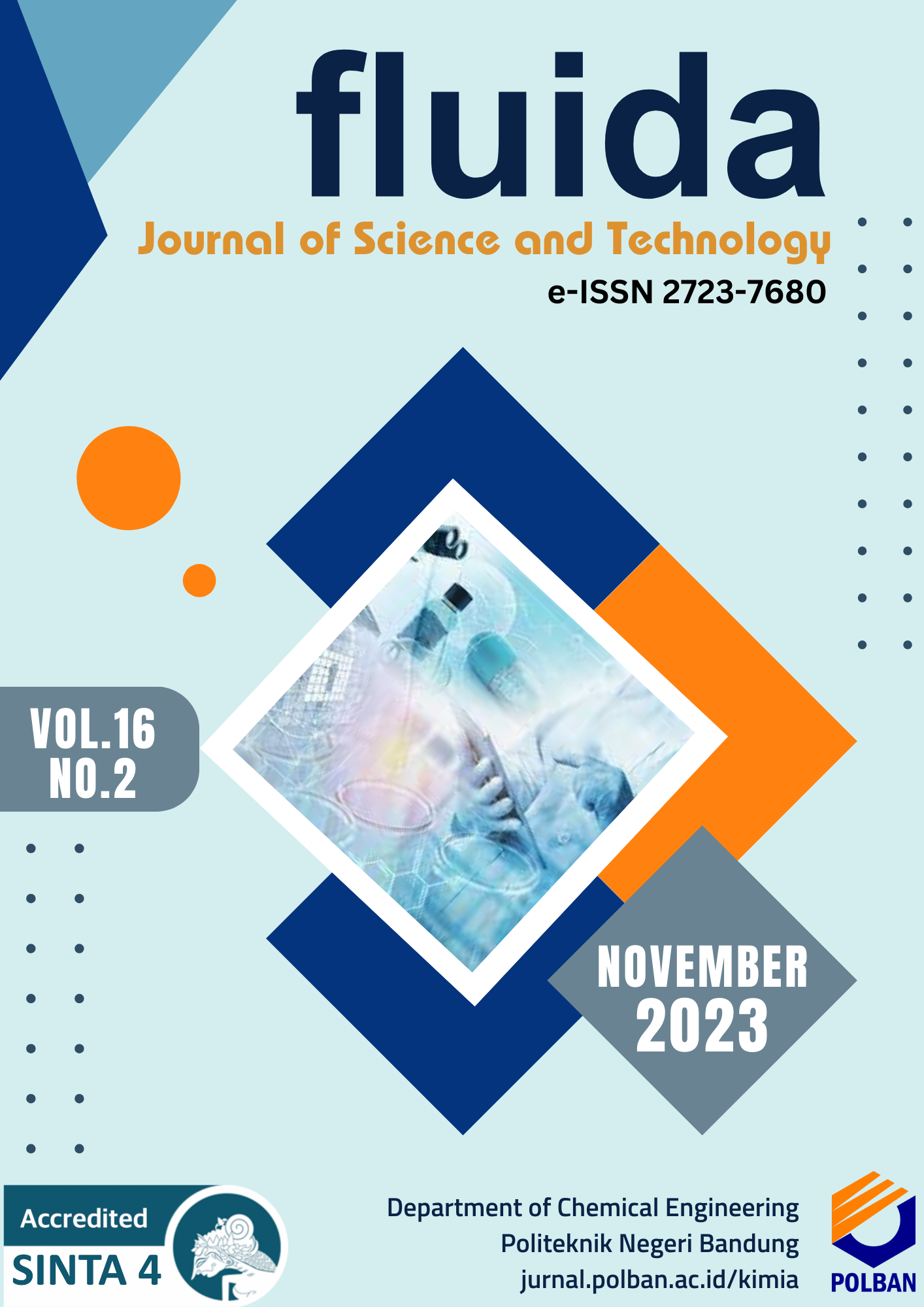Coffee Beans Drying Using Pilot-Scaled Fluidized Bed Dryer Assisted with Zeolite Adsorbent
Main Article Content
Abstract
Drying is a common method applied to agricultural and plantation products to prevent the growth of bacteria and other microorganisms. This research aims to determine the optimum temperature and humidity of the heating air for coffee beans drying in a fluidized bed dryer (FBD) without the addition of adsorbents, to study the effectiveness of zeolite adsorbent as air dehumidifier in order to improve the drying process, and to determine energy consumption in the coffee drying process in an FBD. This research was conducted using 500 grams of Arabica coffee, air temperature variations of 400C, 500C and 600C with an average air velocity of 4.91 m/s. The addition of 1.08 kg of zeolite as an adsorbent was carried out to improve process performance and to reduce the drying time. Coffee bean quality was determined by moisture test using gravimetric method, protein test using Kjeldahl’s method and carbohydrate test using Luff-Schoorl’s method. The results showed that the optimum conditions for drying coffee beans to reduce the moisture content from 28% to 12.45% using an FBD without adsorbent were obtained at a drying air temperature of 500C with a drying time of 3 hours. Coffee bean drying assisted by Zeolite adsorbent was able to reduce the drying time by 11% with the most efficient energy consumption of 76,200 kJ/kg.
Downloads
Article Details

This work is licensed under a Creative Commons Attribution-ShareAlike 4.0 International License.
An author who publishes in the FLUIDA journal agrees to the following terms:
- Author retains the copyright and grants the journal the right of first publication of the work simultaneously licensed under the Creative Commons Attribution-ShareAlike 4.0 License that allows others to share the work with an acknowledgement of the work's authorship and initial publication in this journal
- Author is able to enter into separate, additional contractual arrangements for the non-exclusive distribution of the journal's published version of the work (e.g., post it to an institutional repository or publish it in a book) with the acknowledgement of its initial publication in this journal.
- Author is permitted and encouraged to post his/her work online (e.g., in institutional repositories or on their website) prior to and during the submission process, as it can lead to productive exchanges, as well as earlier and greater citation of the published work (See The Effect of Open Access).
Read more about the Creative Commons Attribution-ShareAlike 4.0 Licence here: https://creativecommons.org/licenses/by-sa/4.0/.
References
[2] FAO, “Guidelines for the Prevention of Mould Formation in Coffee.” 2006.
[3] Felipe A. S. Corradini et al., “Chemical Engineering Research and Design Kinetic study of soybean oil hydrolysis catalyzed by lipase from solid castor bean seeds,” Chem. Eng. Res. Des., vol. 144, pp. 115–122, 2019, doi: 10.1016/j.cherd.2019.02.008.
[4] J. R. D. Finzer, M. A. Sfredo, G. D. B. Sousa, and J. R. Limaverde, “Dispersion coefficient of coffee berries in vibrated bed dryer,” J. Food Eng., vol. 79, no. 3, pp. 905–912, 2007, doi: 10.1016/j.jfoodeng.2006.03.011.
[5] P. C. Corrêa, O. Resende, and D. M. Ribeiro, “Drying Characteristics and Kinetics of Coffee Berry,” Rev. Bras. Prod. Agroindustriais, vol. 8, no. 1, pp. 1–10, 2006, doi: 10.15871/1517-8595/rbpa.v8n1p1-10.
[6] Milton Javier Muñoz-neira, Manuel Fernando Roa-ardila, and Carlos Rodrigo Correa-celi, “Comparative analysis of drying coffee beans using microwave and conventional oven,” Rev. Fac. Ing., no. 95, pp. 100–108, 2020, doi: 10.17533/udea.redin.20191151.
[7] Mohamad Djaeni, Nurul Aishah Aishah, Harum Nissaulfasha, and Luqman Buchori, “Corn Drying with Zeolite in The Fluidized Bed Dryer under Medium Temperature,” IPTEK J. Technol. Sci., vol. 24, no. 2, 2013, doi: 10.12962/j20882033.v24i2.182.
[8] M. J. Carmo and J. C. Gubulin, “Ethanol-Water Adsorption On Commercial 3A Zeolites: Kinetic and Thermodynamic Data,” Braz. J. Chem. Eng, vol. 14, 1997.
[9] Sakchai Dondee, Naret Meeso, Somchart Soponronnarit, and Sirithon Siriamornpun, “Reducing cracking and breakage of soybean grains under combined near-infrared radiation and fluidized-bed drying,” J. Food Eng., vol. 104, no. 1, pp. 6–13, 2011, doi: 10.1016/j.jfoodeng.2010.11.018.
[10] Mohamad Djaeni, Nurul Aishah Aishah, Harum Nissaulfasha, and Luqman Buchori, “Corn Drying with Zeolite in The Fluidized Bed Dryer under Medium Temperature,” IPTEK J. Technol. Sci., vol. 24, no. 2, pp. 13–18, 2013, doi: 10.12962/j20882033.v24i2.182.
[11] Bambang Soeswanto, Ninik Lintang Edi Wahyuni, and Ghusrina Prihandini, “The Development of Coffee Bean Drying Process Technology – A Review,” Proc. 2nd Int. Semin. Sci. Appl. Technol. (ISSAT 2021), vol. 207, no. Issat, pp. 164–170, 2021, doi: 10.2991/aer.k.211106.026.
[12] D. Mulyono and J. C. Runanda, “Pengeringan Gabah Menggunakan Zeolit 3A pada Alat Unggun Terfluidisasi,” J. Teknol. Kim. dan Ind., vol. 2, no. 2, pp. 40–45, 2013.
[13] Suardana, “Optimalisasi Daya Adsorpsi Zeolit Terhadap Ion Kromium(III),” J. Penelit. dan Pengemb. Sains Humaniora, vol. 2, pp. 17–33, 2008.
[14] Ismail Solmuş, Cemil Yamali, Bilgin Kaftanoǧlu, Derek Baker, and Ahmet Çaǧlar, “Adsorption properties of a

